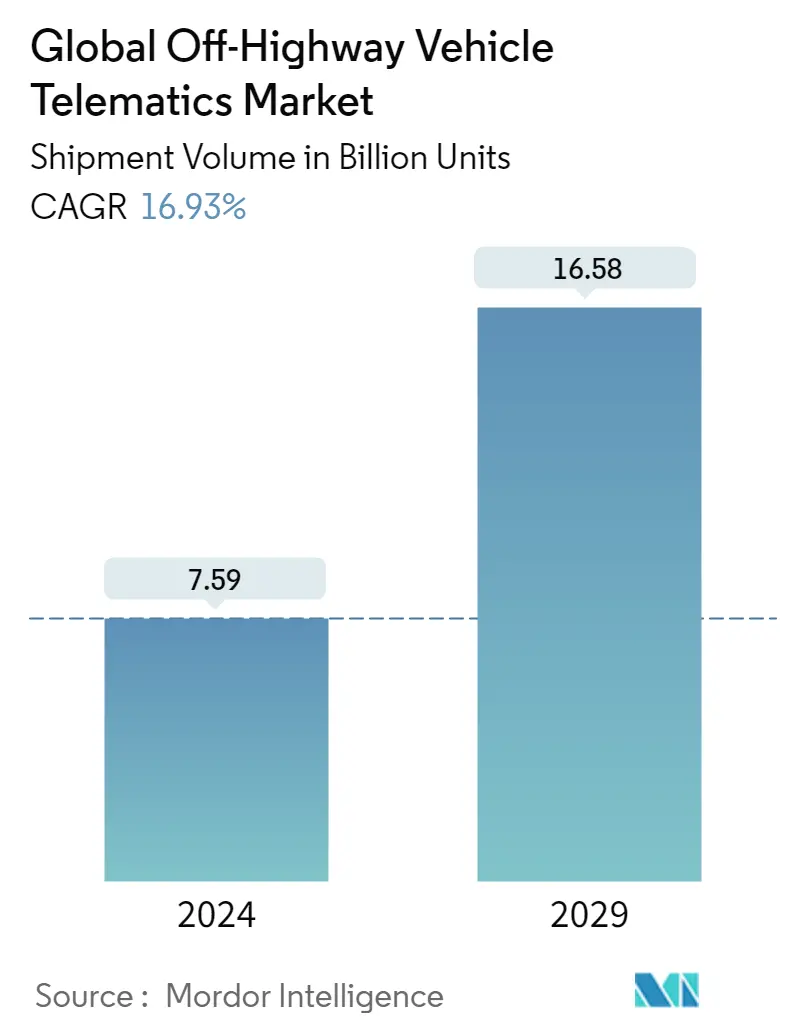Market Size of Global Off-Highway Vehicle Telematics Industry

| Study Period | 2019 - 2029 |
| Base Year For Estimation | 2023 |
| CAGR (2024 - 2029) | 16.93 % |
| Fastest Growing Market | Asia-Pacific |
| Largest Market | Asia-Pacific |
| Market Concentration | High |
Major Players
*Disclaimer: Major Players sorted in no particular order |
Off-Highway Vehicle Telematics Market Analysis
The Global Off-Highway Vehicle Telematics Market size in terms of shipment volume is expected to grow from 7.59 Billion units in 2024 to 16.58 Billion units by 2029, at a CAGR of 16.93% during the forecast period (2024-2029).
The off-highway vehicle telematics market covers a wide range of equipment utilized in the construction, mining, agriculture, and forestry industries, including specialist heavy machinery, lighter gear, and other vehicles. By using off-highway vehicle (OHV) telematics devices that allow GPS, cellular, or satellite connectivity for access to real-time equipment data, off-highway vehicle telematics solutions offer continuous monitoring of the position, condition, health, and utilization of equipment.
- The market for off-highway vehicles consists of various tools, including specialized heavy machinery, lighter equipment, and other vehicles used in the construction, mining, agriculture, and forestry industries. Off-highway vehicle telematics refers to telematics hardware and associated software solutions deployed for remote monitoring and managing fleets of machinery and equipment used in these sectors.
- The main drivers of this industry are the increasing demand for OHV data analysis, increased productivity and utilization, and decreased operational costs related to maintenance and repairs. The telematics industry has been developing quickly as a result of technological improvements. An entirely new experience in terms of bandwidth, faster data uploads, and feedback downloads are provided by upgrading to 4G and 5G networks, leading to more real-time data sets, real-time driver safety, fleet maintenance, and fleet efficiency. Market leaders provide robust location-based services (LBS) and telematics capabilities as part of an intuitive, all-inclusive OHV telematics solution.
- The off-highway vehicle telematics market is driven by regulations in developed regions to equip off-highway vehicles with telematics for improved tracking of vehicle emissions, fuel emissions, driver hour regulation, and accident detection. Telematics solutions are becoming more popular in the heavy-duty, on-highway, and off-highway equipment industries. Major automakers are now including telematics systems as standard equipment on their vehicles, and this trend is spreading to additional models and equipment categories.
- Real-time monitoring of off-highway vehicles and their drivers is made possible by telematics devices. Most fleet managers and off-road vehicle drivers view this as an invasion of privacy and are hesitant to deploy telematics devices in their fleets. Telematics systems gather and send data about, among other things, changes in speed and difficult driving habits, real-time tracking, and vehicle diagnostics. Furthermore, the worldwide off-high vehicle (OHV) telematics market growth is anticipated to be constrained shortly because of growing uncertainty among fleet operators regarding the legal implications associated with the installation of trackers.
- The uncertainty of COVID-19 impacted all vehicle segments and has resulted in regional lockdowns, line closures, and the disintegration of transportation organizations. Furthermore, the financial vulnerability of the off-highway vehicle telematics market due to the pandemic is much higher than it was in previous outbreaks as the lockdown and the virus spread are forcing people to stay indoors. With the increasing number of vehicles owned by corporate fleets, the challenges and pressures to effectively manage the fleet in a challenging business environment are increasing, which could drive the OHV Telematics Market.
Off-Highway Vehicle Telematics Industry Segmentation
Off-highway vehicle telematics solutions continuously monitor device location status, status using OHV telematics devices that support GPS, cellular, or satellite connectivity to access real-time device data. The use of technology in the industry has been beneficial, vehicle telematics has proved to be very efficient in real-time for drivers, car owners, and fleet managers. The global Off-Highway Vehicle Telematics Market is segmented By End-user Industry (Construction, Agriculture, Mining, Forestry), and Geography.
| By End-User Industry | |
| Construction | |
| Agriculture | |
| Mining | |
| Forestry |
| By Geography | |
| North America | |
| Europe | |
| Asia Pacific | |
| Latin America | |
| Middle East and Africa |
Global Off-Highway Vehicle Telematics Market Size Summary
The off-highway vehicle telematics market is poised for significant expansion, driven by the increasing integration of telematics systems in construction, mining, agriculture, and forestry sectors. These systems, which utilize GPS, cellular, and satellite connectivity, enable real-time monitoring of equipment, enhancing productivity and reducing operational costs. The market is experiencing rapid growth due to technological advancements, such as the transition to 4G and 5G networks, which facilitate faster data transmission and improved fleet management capabilities. Regulatory pressures in developed regions to monitor vehicle emissions and enhance safety are further propelling the adoption of telematics solutions. Despite concerns over privacy and legal implications, the demand for telematics in off-highway vehicles is expected to rise, supported by the growing need for efficient fleet management and asset utilization.
The market's growth is also fueled by increasing infrastructure development activities, particularly in Asia, where countries like India and China are investing heavily in public infrastructure projects. This surge in construction activities is expected to drive the demand for off-highway vehicles equipped with telematics systems. The construction sector, in particular, is witnessing a shift towards digital transformation, with telematics playing a crucial role in tracking equipment performance and ensuring efficient asset management. The competitive landscape is intensifying, with major players like Caterpillar, Komatsu, and Hitachi Construction Machinery leading the charge in offering integrated telematics solutions. Strategic partnerships and technological innovations are further enhancing the market's growth prospects, as companies strive to meet the evolving demands of the construction and heavy machinery industries.
Global Off-Highway Vehicle Telematics Market Size - Table of Contents
-
1. MARKET DYNAMICS
-
1.1 Market Overview
-
1.2 Market Drivers
-
1.2.1 Regulations and OEM Proliferation
-
1.2.2 Increase in Technological Developments
-
-
1.3 Market Restraints
-
1.3.1 Growing Reluctance of End Users to Change Business Practices
-
1.3.2 Lack of Training for the Use in Heavy Equipment
-
-
1.4 Industry Attractiveness - Porter's Five Forces Analysis
-
1.4.1 Bargaining Power of Suppliers
-
1.4.2 Bargaining Power of Buyers
-
1.4.3 Threat of New Entrants
-
1.4.4 Intensity of Competitive Rivalry
-
1.4.5 Threat of Substitutes
-
-
1.5 Regulations and Mandates
-
1.6 Assessment of Impact of COVID-19 on the Market
-
-
2. MARKET SEGMENTATION
-
2.1 By End-User Industry
-
2.1.1 Construction
-
2.1.2 Agriculture
-
2.1.3 Mining
-
2.1.4 Forestry
-
-
2.2 By Geography
-
2.2.1 North America
-
2.2.2 Europe
-
2.2.3 Asia Pacific
-
2.2.4 Latin America
-
2.2.5 Middle East and Africa
-
-
Global Off-Highway Vehicle Telematics Market Size FAQs
How big is the Global Off-Highway Vehicle Telematics Market?
The Global Off-Highway Vehicle Telematics Market size is expected to reach 7.59 billion units in 2024 and grow at a CAGR of 16.93% to reach 16.58 billion units by 2029.
What is the current Global Off-Highway Vehicle Telematics Market size?
In 2024, the Global Off-Highway Vehicle Telematics Market size is expected to reach 7.59 billion units.

